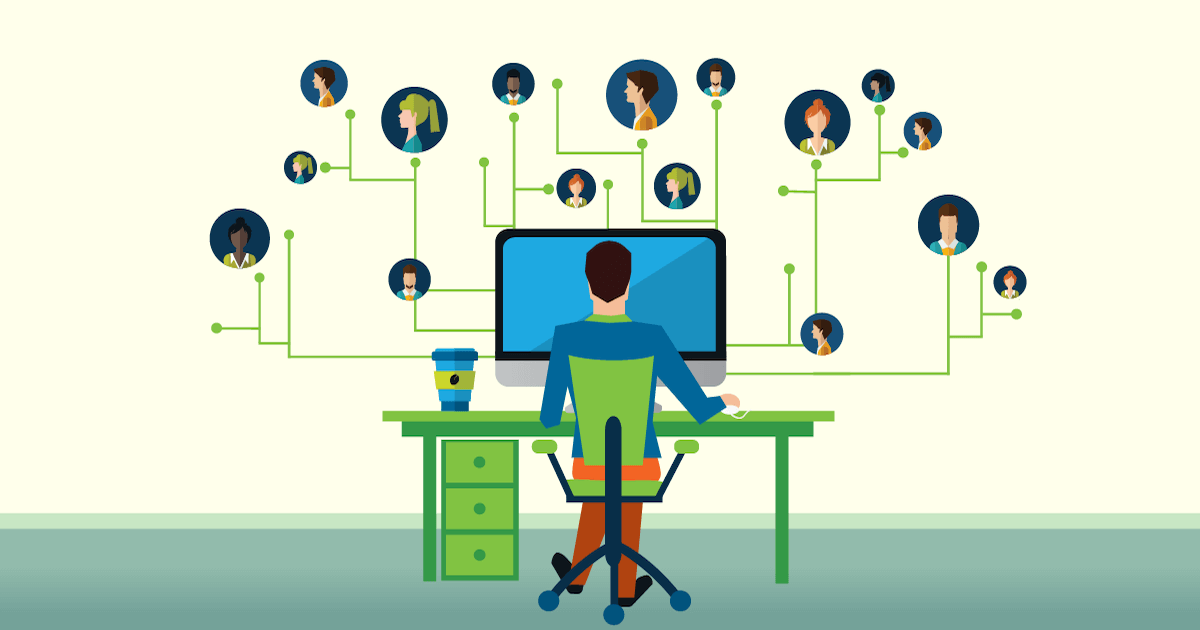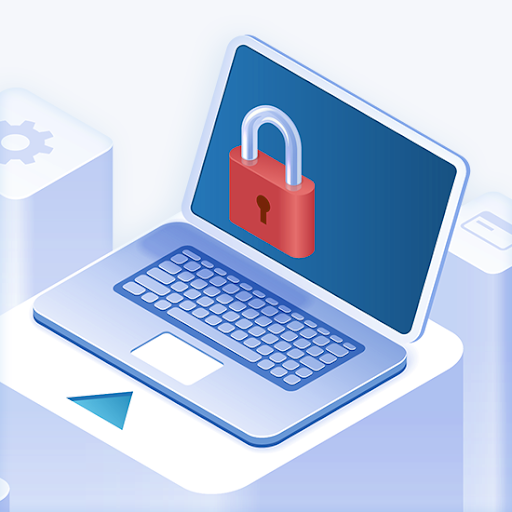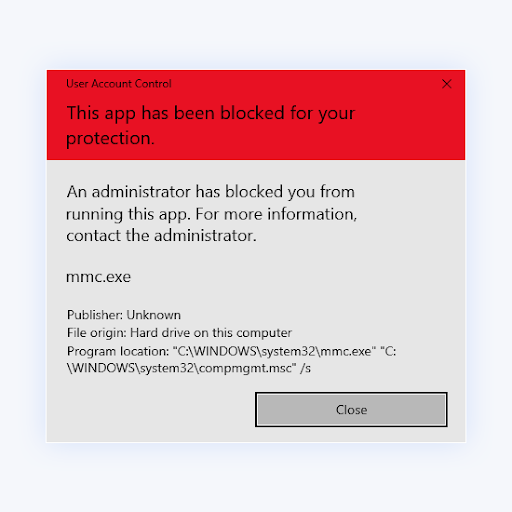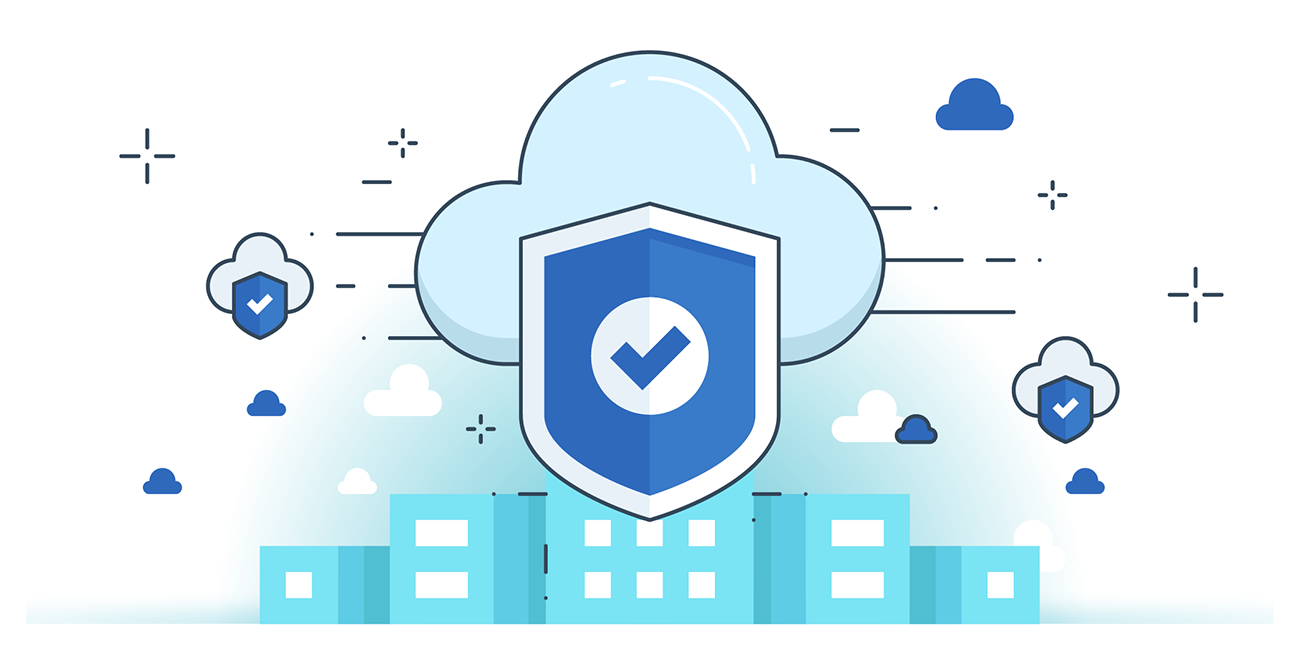Solved: Connected to Wi-Fi but no Internet
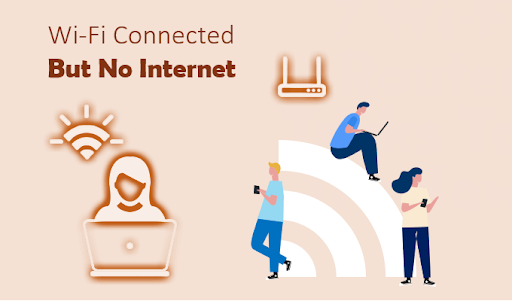
The problem of “connected to Wifi but no Internet” is common and frustrating. Being connected to Wi-Fi but no Internet access can be confusing and frustrating.
We looked at this common issue and developed this guide to help you understand why you’re connected to Wi-Fi but no Internet access.
Use this guide to improve your Wifi and network performance as well as speed to eliminate one of the most frustrating issues one can encounter: Connected to Wi-Fi but no Internet.
What Causes Connected to Wi-Fi but no Internet
Why I'm I connected to WiFi but no internet?
If you’re using a Wifi connection or Wireless connection, you may encounter an error message that states, “Wi-Fi connected but no internet.” This message means that your device/computer is connected to your Internet source (router/modem) correctly, but it is not connecting to the Internet.
When this error occurs, you will see a small, yellow warning triangle with a black exclamation mark on Windows computers. If you’re using a mobile device, it will show a black exclamation mark.
In many cases, the issue is due to changes in the settings of your operating system. The router is also a major culprit when you’re connected to the Wifi, but you have no internet access. However, these causes may not always be so apparent.
Other apparent causes of Wi-Fi connected but no internet access include:
- Faulty Wifi adapters on your device.
- Faulty internet router.
- Your internet service provider is down.
- Your computer’s IP address is incorrect.
- Security software is preventing access (antivirus)
- Out of date wireless drivers.
- Wrongly configured DNS server settings.
- Corrupted DNS cache or DNS cache conflict
These different causes mean you’ll have to try different fixes to identify the right one.
Wi-Fi connected but no internet: Is It One Device or the Network?
Before you start troubleshooting, you need to know if the problem of no internet connection is only on your device or the entire Network.
This will help you narrow down the likely cause and use the correct method for solving the problem.
If it is just a single computer/device with a Wi-Fi connection but no internet, it is likely that you have faulty drivers or a Wi-Fi adapter. Alternatively, the issue may be a misconfigured setting, DNS issues, or a problem with your IP address. If all devices have a Wi-Fi connection but no internet, it is likely that your internet provider is down or you have a problem with your router/modem.
Tip: If you’re not familiar with the Windows 10 interface, we recommend reading our How to Get Started with Windows 10 article before troubleshooting.
How to Fix WIFI Connected But No Internet in Windows 10
How do I fix internet connection? Use this guide to fix Wi-Fi connection problems on your computer.
Note: Before you proceed to the technical solutions, try to disable or remove your AV software, firewall, or security software. Some security software can cause the problem of internet connection errors on your PC. They block outgoing network traffic because of a fault or configuration error.
1]: Use Windows Network Troubleshooter
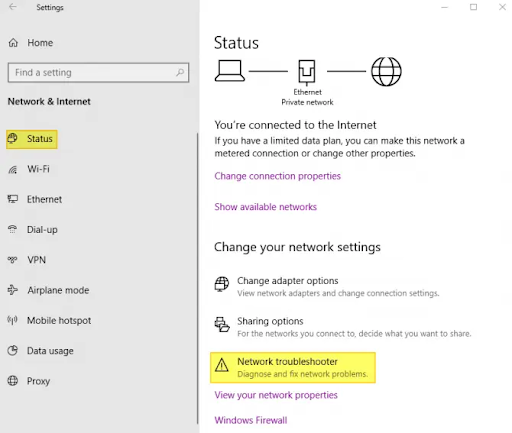
Windows 10 has a built-in Windows Network Troubleshooter that can come in handy when you’re experiencing internet connection issues. The Windows Network Troubleshooter may be able to rectify the problem automatically.
- Open Windows Settings: Press Wins Key + I.
- Click on the “Network & Internet” option.
- In the left pane, click on the “Status” option.
- Click on the “Network Troubleshooter” option.
- Now, run the Network troubleshooter to see if it solves the problem.
2]: Flush DNS (Domain Name System)
If your device’s DNS cache becomes corrupted, either by a technical glitch or malicious code, it can cause a mismatch/conflict in your IP address (IP address conflict or DNS cache conflict). This will prevent you from connecting to a particular internet even if you can connect to the Wi-Fi successfully. The solution is to flush your DNS connection.
To flush your DNS:
- Press Wins key + S, then type in “cmd.”
- On the command prompt, select Run an administrator.
- Now type in the following commands and hit Enter after each one.
ipconfig /flushdns [press Enter].
ipconfig /release [press Enter].
ipconfig /renew [press Enter].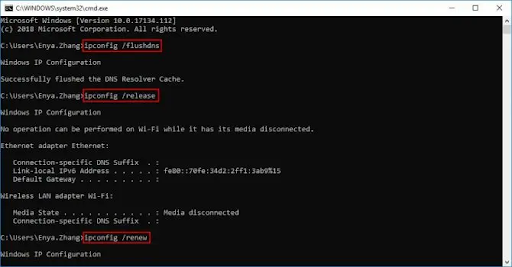
- Once this is done, close the command prompt and see if you now have an internet connection.
3]: Disable First Startup in Windows 10
If your PC’s Fast Startup is enabled to shut down and power on quicker, it may be interfering with your internet connection even when you’re connected to Wi-Fi.
You can consider turning off First Startup to help you solve the problem.
To disable First Startup, use the following steps:
- Press Windows key + X to open Windows Quick Access Menu.
- On the list of items, select Power Options (third item on the list).
- Now, select Additional power settings (located on the right side or bottom).
- Next, on the left pane, click on Choose what the power buttons do.
- Next, click on Change settings that are currently unavailable.
- Now, uncheck the box next to Turn off the fast startup.
- Finally, click Save Changes, then reboot your PC.

4]: Update your Network Adapter driver
Outdated drivers often cause common problems in computer functionality. If your network adapter driver is outdated, you may experience the issue of connected to Wi-Fi but no internet.
To update your driver, do the following:
- Press Windows key + X to open Windows Quick Access Menu.
- On the list of items, select Device Manager (sixth item on the list).
- Now, expand Network adapters.
- Locate your Wireless network adapter in the expanded list.
- Right-click on the adapter > then select Update Driver software.
- In the new Window, select Search automatically for updated driver software.
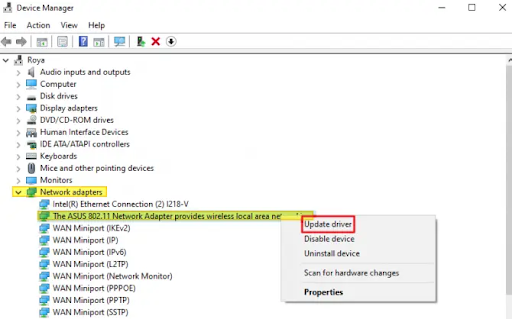
Allow Windows to search for a newer driver and install it. Once the process is complete, restart your PC, then reconnect to the Wi-Fi and see if you’re still experiencing the problem.
Note: If Windows fails to update the driver to the newest version automatically, you may need to install the right one manually from your PC’s manufacturer or motherboard’s manufacturer.
5]: Turn off IPv6 support in your computer or router
Although new, most new network devices support IPv6 for addressing IP Addresses. IPv6 works well for most devices, but it can also cause a few network errors and problems.
The good news is that you can safely turn off IPv6 in your home networks and use IPv4 because all devices support the older IPv4 protocol.
The best place to turn off IPv6 is your router. While each router may be different, in general, you will just login to your router, look for Network Settings, DHCP, or LAN and turn off IPv6.
Here’s how to turn off IPv6 on your computer:
- Right-click on Windows Start > select Network Connections.
- Next, select Change Adapter Options.
- Doubleclick on the Wi-Fi Adapter to open your Network Adapter.
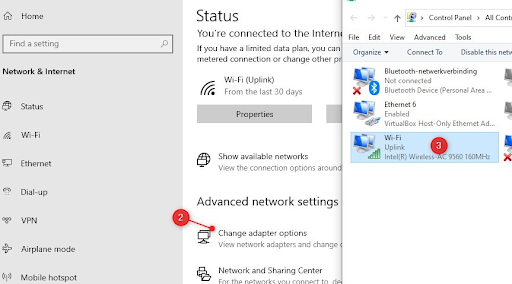
- Select Properties.
- Uncheck the box next to Internet Protocol version 6 (TCP/IPv6) to turn it off.
- Click OK, and reboot your computer.
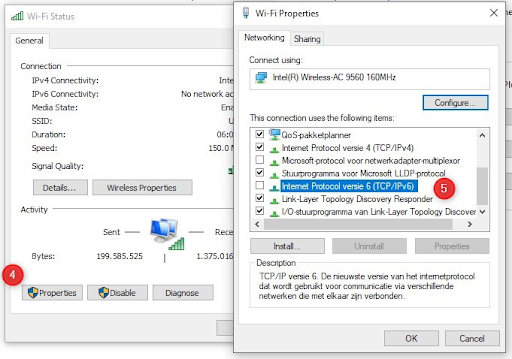
6]: Check your network validity and DNS server address
- Right-click on Windows Start > select Network Connections.
- Next, select Change Adapter Options.
- Doubleclick on the Wi-Fi Adapter to open your Network Adapter.
- Select Properties.
- Locate and double click the entry labeled “Internet Protocol Version 4 (TCP/IPv4)”.
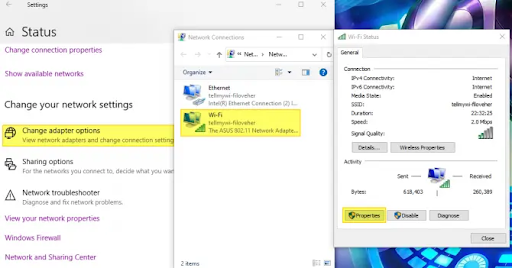
- In the new Window, check and make sure that both the IP address and DNS server. address are set to be obtained automatically.
- If so, click OK and try your internet connection again.
- If not, set them to obtain automatically, then click OK and restart your computer then try your internet connection again.
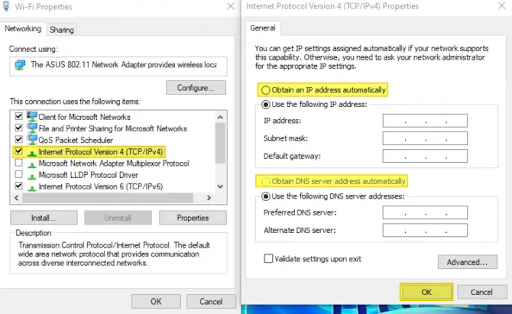
- If obtaining the IP address and DNS server address automatically still doesn’t work, you can set them manually.
- Click “Use the Following DNS Server Address” the enter the preferred DNS server “8.8.8.8”
- For Alternate DNS server enter “8.8.4.4”
- Click OK then test your Internet again to see if this resolves the issue.
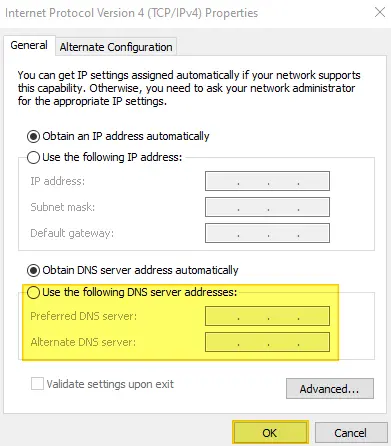
7]: Turn-off 5Ghz – Change wireless network standard
Today, thanks to technology improvements, almost every laptop and mobile phone support both 2.4Ghz and 5Ghz wireless networks. Although 5Ghz wireless networks are faster, it has a shorter range.
Many devices will always try to use the 5Ghz wireless networks, which can sometimes lead to the Wi-Fi Connected but no Internet. This can be because of a broken antenna, a bug in the driver, or even an access point because of short-range.
You can make your computer connect to the Internet over 2.4Ghz to see if the 5Ghz is the problem:
- Right-click on Windows Start > select Network Connections.
- Next, select Change Adapter Options.
- Double-clicking on the Wi-Fi Adapter to open your Network Adapter.
- Click on Properties > then Configure.

- Go to the Advanced tab > Select 802.11n/ac wireless mode > change it to off.
- This will enable your computer to connect over the 2.4Ghz channel.

Note: If this solution works, you can try to set the 802.11n/ac wireless mode to 802.11n. This will allow you to still use the faster 5Ghz bandwidth, but only with a slower protocol.
What if “Connected To Wi-Fi But No Internet” is across your entire Network?
If you’re experiencing an internet connection problem across the entire Network, it means the problem is not with your computer. So you can try the following solutions:
Read: » How to Fix Slow Startup on Windows 10
1]: Reset/Reboot your Router or Modem
Rebooting your router and modem can help resolve the issue.
You can turn off your router, power it down, then unplug it from the power socket and let it rest for about a minute, then plug it back in and turn it on again. Once done, test your devices again to see if the issue is resolved.
2]: Check to see if your ISP is down
The issue you’re experiencing may also be due to your Internet Service Provider. If all of your devices connect to your wireless network, but you cannot access the Internet, there may be a possible outage with your service provider.
You can either use your cellular data to look up your internet service provider’s network through their website or social media pages or call your ISP for inquiry.
3]: Reset your entire Network.
If, after all these solutions, you’re still experiencing the “Wi-Fi connected but no internet” error, you may need to reset your entire Network. This way you’ll reset all of your network settings back to their default state and remove all network adapters as well.
Here’s how to reset your Network:
- Press Wins Key + I to go to settings > select the “network & internet” option.
- In the left pane, click on the “status” option.
- Locate “network troubleshooter”> then find “network reset”
- Click on “network reset” and follow the on-screen instructions.
Once you’ve reset the Network successfully, you can reconnect to the Internet by clicking on your Internet’s taskbar icon. You may need to reenter the password and username of your Networks for all the devices.
Finally
The “connected to Wi-Fi but no Internet” error is a common yet frustrating problem. It not only stops you from getting connected to the Internet but can also frustrate your internet activities. We believe that these solutions can help you sort the issue and allow you to continue using the Internet.
One More Thing
If you need any further help with Windows 10, don’t hesitate to reach out to our customer service team, available 24/7 to assist you. Return to us for more informative articles all related to productivity and modern-day technology!
Would you like to receive promotions, deals, and discounts to get our products for the best price? Don’t forget to subscribe to our newsletter by entering your email address below! Receive the latest technology news in your inbox and be the first to read our tips to become more productive.
You may also like to Read
» WiFi Keeps Disconnecting on Windows 10? Here’s the Fix
» Solved: No Internet Connection Windows 10
» Slow Internet on Windows 10? Here’s How To Solve It




